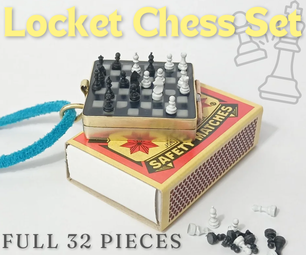Introduction: Beginning to Paint Monochromatically
Hello, MadMC here!
Today, I want to share some tips and tricks to help you begin your painting journey.
The hardest part of painting is getting started. Painting can be as simple as a canvas and a bucket of paint, or the most complex line of products. And sometimes, it's difficult, even for accomplished artists, to decide what to paint and what to use. But, as many artists have found, the process is just as enjoyable as the finished product!
So, Let's Get Started!
Supplies
1. A photo called ALT03* by Hengki Koentjoro. (Go check him out! His photos are amazing!)
2. Master's Touch Acrylic (Liquitex, Student Grade works well also):
- Ultramarine Blue
- Cadmium Red
- Cadmium Yellow
- Titanium White
3. Primed, 9x12 box canvas
4. Paint brushes (filbert, bright, rigger)
5. Water containers
6. Paint rag
7. Painting palette
8. Painting station
*copyrighted and received permission for use by Hengki Koentjoro
Step 1: Select a Subject and a Color
Figure 1: Edited Image of Mountains and Ocean on Fotor, a Free Photo Editor
- Look for Contrast
Choose an image that has plenty of light and dark areas throughout the image. The more contrast it has, the better the painting will turn out.
- Look for the Flow
Make sure the image isn’t flat, and your eye moves through the image. When your eye moves through an image, it starts at the focal point and follows a line. The line will be different depending on whether the image is symmetrical or asymmetrical. Take the image above; it draws your eye to the darkest spot first, then follows the line of the mountains to the lighter background and then follows the white surf of the shore back to the front of the image. It creates a balanced effect in the image.
Try to find the focal point of your images and pay special attention to these areas when you begin painting.
- Focus, Focus
Make sure the image is a clear. It's easier to start with an image that's in focus, otherwise it can be hard to paint realistic features, shading, and proportions. Unless it’s an intentionally unfocused image, go with an image that is clear and has crisp edges.
- Pick Any Color!
“Monochrome” doesn’t just mean black and white; it means varying tones of one color. So go hog-wild! Go paint that horse green! Paint your friend purple! The choice is yours!
Step 2: Pick a Paint, a Surface, and a Utensil
Figures 2-4: Images of Paints, Surfaces, and Utensils, Respectively
- Choose the Type
Sometimes painting is hard just because there’s so many ways to do it. Don’t let that get you down! Go with your gut! You can always go back and begin afresh with different materials.
The most common materials that are easy to find are:
Acrylics, Oils, Watercolor
Canvas, Wood, Paper, Glass
Brushes, Palette Knives, Sponges, and your fingers!
NOTE: Oil paints are more difficult to work with because of how we clean them up. Oil is famous for using turpentine. But please be very careful with this substance. It’s dangerous to breathe in and can start fires if not properly handled.Walnut Oilis a good substitute for it.
As a general rule, acrylic and watercolor are easier to clean up and a bit easier to work with than other paints. Oil takes much longer to dry than either acrylic or watercolor, but don't let that deter you from trying oil paints. They have a really nice texture and depth to them; it just takes much longer to finish an oil painting than an acrylic painting. For this reason, I have chosen to use acrylic paints to demonstrate this project.
- Check It Before Buying
Check the type of paint before you buy it. Many kinds of paint have different qualities and textures. It’s a good idea to get the same brand, and enough of it, when you go the first time because the shade of the color or texture may be different the next time you go to get it.
- Don't Settle
There are many different materials out there, especially for the surfaces. Theoretically, as long as you prime it, you can paint on any surface. Don’t settle for a store-bought canvas that’s not quite the right size you want. Canvas, wood, glass, and paper come in many ways.
TIP: Craft stores aren’t the only places you can find cool little knick knacks to use for surfaces and utensils. Stores like Home Depot and Lowes, and even the Dollar Store, have a good selection of cool stuff. So raid those home project sections!
Step 3: Prime It!
Figures 5-7: Images of Covering the Canvas with White Paint
- Chose the Primer
Priming a surface is very important, so make sure to do this step before you begin painting!
There are just as many primers as there are paints. Make sure you get the primer you want. Some primers are specifically for certain paints. Some are tinted, some clear. Pick the one that fits your project. I use this one most often for acrylic projects.
- Safety First!
After you chose the primer, make sure to have the proper ventilation and protective gear, if necessary. Be safe using all those substances!
- Prep the Surface
Coat the entire surface sufficiently. The paint won't settle right on the canvas if some spots have primer and some spots don't. Make sure the coats are even, too. The paint won’t look the same across the surface if the primer isn’t as even as possible.
- Cover It White
Put a layer of white paint over the canvas, primed store-bought and self-primed alike, to fill in the gaps, as I demonstrate above. This adds depth to the acrylic and helps the paint fill the surface fully.
TIP: Have a separate space for your priming. It usually takes a long time for primers to dry.
Step 4: Prep and Set-up Your Station
Figures 8 & 9: Images of Painting Station and Mixing Paint Examples
- Get Dirty
Put on your most ratty-tatty clothes you won’t miss to help you get in the mindset of painting. If you worry too much about where the paint is going to end up, it’ll detract from your painting.
But still make sure their comfortable! Nothing’s worse than itchy paint clothes!
- Make Space
Have plenty of space to set up your painting station.
And, test the lighting around your station. It’s important to have lots of light, natural or electric. (Although, electric lighting changes how the finished painting looks hung up.)
TIP: Set up your painting station with the mindset that it will stay up for days, even months. This will relieve some of the pressure to finish your project and get you in the mindset to enjoy the process.
- Have Everything Within Reach
Have plenty of water, rags, and paint within reach of your station. It’s a pain to have to constantly get up to retrieve supplies; it draws out the process and strains motivation.
TIP: I have three containers of water at my station-- one to dump dirty water in, one for clean water, and one for actual use. I also use an old beach towel for messes and cleaning my brushes. I also use a big roll of paper towels if it's handy.
- Mix Big Batches
Mix big batches of paint if you’re mixing your base color. Or, buy more than you think you’ll need for the project to make sure you have enough. It’s a nightmare to get the right color, only to then run out of it.
TIP: For this project, I made my own black. To make black, mix cadmium red, cadmium yellow, and ultramarine blue in equal parts until you get the shade of black you want. It's really easy to make a lot because you have to correct it here and there to get it right, but a good black is always nice to have. Make sure to have an airtight container to store it in. (And mixing different colors together first gives you different shades of black. Yellow and red first gives you a more asphalt black, while blue and red first is more of an night, ink black.)
TIP: If you are painting in a color other than black and white, make sure to have its complementary color around. The color looks more naturally dulled and realistic if you use the complementary color to shade. For red use green, orange for blue, purple for yellow, and vice versa.
- Don't Forget the Music!
Music is the most important part of painting. It sets the mood and can help you focus on painting. So put on some beats and let the music move you!
Step 5: Begin Painting
Figures 10-12: Images of Painting the Base Coat
- Paint the Base
Don't skimp! Use a bunch of paint for the base layer. It adds depth and texture to the surface of your painting.
Get all the crevices by painting the surface one direction. Repeatedly go over each line to make sure all of the spots get covered. Move quickly enough, though, so the paint doesn’t dry on one end before you get to the other.
TIP: Use the light around you and let it reflect on the surface of the painting to catch the places that aren't covered enough.
- Make It Look Professional
Cover the sides of the canvas to give your painting a professional feel to it. It feels more complete, too, when you wrap the paint around the edge. Make sure to smooth out as many globs of paint on the canvas as you can.
Step 6: Paint the First Layers
Figures 13-15: Images of the Painting Process From Basic to Detailed
- Add in the Basics of the Image
Don't get too detailed right away.
Fill in just the very basics to get an idea where everything is. This helps with the proportions.
Don't worry so much about the accurateness of it; you can go back and fix it later. The point the first time around is to make a gesture of the image only.
- Start the Specifics
Don't work from one corner to the next. Spread your work throughout the painting and add more and more specific details as you go. This will help keep you from spending lots of time trying to get one area correct, only for it to be out of proportion with the rest of the painting.
- Concentrate on Contrast
Focus on the specific light versus dark areas within the painting. Look at the little changes in shade of the color and try to copy it.
TIP: Make sure to look at your image often! When you get too caught up in your painting, things get out of proportion or don't look like the image.
- Fill In the Edges
Once you begin the specifics, make the effort to watch your lines. Clean lines and edges help define the painting. It also helps to distinguish the contrast in the painting.
Step 7: Sharpen the Details and Shades
Figures 16-19: Images of Painting Techniques
- Use the Edges
Use the edge of the brushes to push paint to the places you need. Painting the details requires precision, and paint brush edges help you get that.
- Blend with the Brush, Not the Paint
Use your palette to test the mix of colors and shades on your brush. Many use their palette knives to mix their colors and shades, but for small bits of color that you're using for shading, use your brush to mix them. You can check the color more easily on the painting.
When you put the paint on the canvas, spread it around with your brush. Don't get too aggressive with the brush, but do push the paint into the canvas. Use the friction between the paint brush and canvas to help move the paint in the right ways.
TIP: If the paint is too sticky or thick, add a bit of water to your brush. It'll loosen the paint, make it thinner, so you can smooth it onto the canvas.
- But Use the Paint, Not the Brush
Make sure that there is enough paint on the brush to get the right effect on the canvas. For acrylic, a tiny bit of paint on the brush dries quickly. Using bigger amounts of paint allows you to mix on the canvas for layered shading, to get the effect of milk settling in coffee.
- Turn It Upside Down
Don't worry if you get stuck! We ALL do at some point! So if you do, turn it upside down and paint it that way. This tricks out your brain. It lets you see the image as just a bunch of shapes and light and dark areas.
Step 8: Make Your Mark
Figure 20: Image of Up-close Signature on the Finished Painting
- Sign That Thang!
It’s your right as a creator to let everyone know that it’s your creation. So make sure you sign your art!
Your signature could be a pretty squiggle, fancy initials, or just simply your name. You could put it in the front, the top, bottom, centered like a watermark, in the corner, or even on the back. It's up to you, but make sure people know it's yours!
Step 9: Finish With a Plan
Figure 21: Image of a Frame
- Pick a Way to Present Your Piece
There are a few ways to present your art. You could even not show anyone if you really don't want to. But don't be ashamed of your art! Plan to display it and be proud of it!
Depending on the type of art, some ways of presenting look more pleasing. For instance, you could:
Leave It Just Like It Is
Box canvases and wood panels are the best to simply hang up without any embellishments. These still need a way to be hung, so make sure to check for hook and wire or string strengths before you hang it.
Frames
Lots of art forms need assistance to hang or look professional. Some of these include: paper, watercolor paper, canvas paper, and canvas board.
Depending on the surface, it looks nicer in certain types of frames. Check out the options before you settle on a frame. Some look better in lighter wood or floating glass frames. It all depends on the effect you want.
Finishers
Of course, some surfaces, like desk tops and cups and such are more for actual use. These need finishers instead. Depending on the paint used, there are different finishers available. I personally have used modge-podge for glasses and surfaces that will be around water. There are also sprayable finishers. Just be careful of toxicity when you use them!
Step 10: Show Off Your Masterpiece!
Figure 22: Image of the Finished Painting, Hung on a Bedroom Wall
Make sure to display your masterpiece when you finish it. Everyone deserves to show off their art!
Now go forth and enjoy your painting adventure!
See you next time, MadMC out!
Work Cited
Koentjoro, Hengki. "ALT03." Hengki Koentjoro, 2015, http://www.hengki-koentjoro.com/gallery#/altitude

Participated in the
First Time Author Contest








